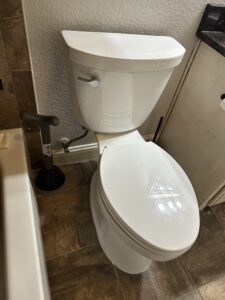How Does a Toilet Work?

The humble toilet is an essential fixture in every home, yet most of us rarely think about how it works. It’s an ingenious combination of mechanics and plumbing designed to safely and efficiently remove waste. Let’s break down how a standard gravity flush toilet operates.
1. The Tank: Holding the Key to the Flush
At the back of most toilets is the tank, a water reservoir that plays a central role in flushing. The tank is filled with water after each flush, which is stored until the toilet is used again. Inside the tank, there are several key components:
- Fill Valve: This component allows water to refill the tank after each flush. When the water reaches a certain level, it automatically shuts off.
- Float: This is attached to the fill valve and rises with the water level, signaling the valve to close once the tank is full.
- Flapper: A rubber valve at the bottom of the tank, which opens when you flush the toilet, allowing water to rush into the bowl.
2. The Flush: Creating a Powerful Flow
When you push the toilet handle, a lever pulls the chain attached to the flapper, lifting it from its seat at the bottom of the tank. This action releases the water in the tank, which flows into the bowl quickly and with enough force to push the waste out through the trapway and into your home’s plumbing system.
The gravity-fed design ensures that water from the tank has enough pressure to clear the bowl efficiently. Modern toilets are designed to use a minimal amount of water for each flush (usually between 1.6 to 1.28 gallons).
3. The Bowl: Siphon Action
The toilet bowl has a built-in siphon that helps create the vacuum needed to pull waste down into the drain. As water enters the bowl, it begins to fill the siphon tube, which curves like an “S” at the back of the toilet. Once the water fills and overflows this curve, the siphon is activated, pulling both the water and waste down the drain.
When the water level in the bowl drops below the siphon, the air is reintroduced into the pipe, breaking the vacuum and stopping the siphon action. This prevents any further waste from being pulled into the drain until the next flush.
4. The Refill Process: Ready for Next Use
After the flush, the fill valve reactivates, drawing water back into the tank and slowly refilling the bowl. The flapper closes once the tank is empty, ensuring no water continues to leak out. Once the float rises to its predetermined level, the fill valve shuts off, stopping the water flow until the toilet is flushed again.
How Do Low-Flow Toilets Work?
Modern toilets are designed to be water-efficient. Low-flow toilets use less water per flush, typically around 1.6 gallons compared to older toilets that might use 3-5 gallons. They achieve this efficiency by optimizing the design of the bowl and the trapway to ensure that the reduced amount of water still creates the necessary siphon and pressure to clear waste.
Common Toilet Issues
Though toilets are generally reliable, they can develop issues over time, including:
- Clogs: If something gets stuck in the trapway or drain pipe, the toilet may not flush properly.
- Running Toilet: If the flapper doesn’t close completely after a flush, water will continue to flow into the bowl, leading to a constantly running toilet.
- Weak Flush: A weak flush can occur if the water level in the tank is too low, or if mineral deposits build up in the rim holes where water enters the bowl.
Conclusion
The toilet may seem simple, but it’s an impressive piece of engineering that combines gravity, water, and siphon technology to efficiently remove waste. Understanding how a toilet works can help you diagnose and fix common issues or appreciate the role this essential device plays in your home’s plumbing system.
Categories: Toilets,By: Michelle Kurcina
Last modified:
Last Modified: September 10, 2024 at 2:25 pm


